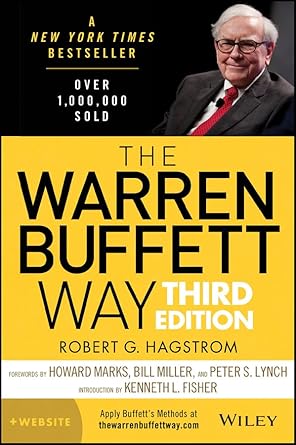Your cart is currently empty!
02.0008 The Warren Buffett Way

The Warren Buffett Way
2014 Robert G. Hagstrom
John Wiley & Sons, Inc.
| Chapter | Value Investing |
|---|---|
| Foreword: The Exception (Howard Marks) | He started Buffett Partnership in 1956 with $105,000. Since then, he attracted additional capital and earn returns on it such that Berkshire Hathaway now has investments totaling $143 billion and a net worth of $202 billion. |
| Foreword to the 2nd Edition (Bill Miller) | And principals do not change. Warren saying “That’s why they call them principles.” |
| Foreword to the 1st Edition (Peter S. Lynch | 11 employees. There was not a computer or a stock quotation machine to be found. |
| Personal qualities: very contented, discipline, patience, flexibility, courage, confidence, and decisiveness. To eliminate / minimized risk. He is very depth at probability and as an oddsmaker. Inherent love of simple math computation. He can make a decision not to invest in something in as little as 2 minutes and conclude that it is time to make a major purchase in just a few days of research. | |
| Warren states that 12 investment decisions in his 40-year career have made all the difference. | |
| Risk can br reduced greatly by concentrating on only a few holdings if it forcrs investors to be more careful and thorough in their resesrch. Normally more than 75 percent of Berkshire’s common stock holdings are represented by only 5 different securities. | |
| Berkshire annual report after 1978: The format became more similar to the partnership reports he had produced from 1956 to 1969. Including dos and don’ts of proper investing in stocks. | |
| Setting growing intrinsic value by 15 percent a year over the long term. June 1993 annual report on page 60: “Berkshire has not declared a cash dividend since 1967.” | |
| Introduction (Kenneth L. Fisher) | – |
| Preface | “What we do is not beyond anybody else’s competence,” said Buffett. “I feel the same way about managing that I do about investing: It’s just not necessary to do extraordinary things to get extraordinary results.” |
| He thinks about the business, the people who run the business, the economic of the business, and then the value of the business, and in each case he lays wahat he learns against his own benchmarks. -Investment tenets: business, management, financial, market. | |
| 1996 annual report: ” Your goal as an investor should be simply to purchase, at a rational price, a part interest in an easily understood business whose earnings are virtually certai to be materially higher, 5, 10, and 20 years from now. Over time, you will find only a few companies that meet those standards – so when you see one that qualifies, you should buy a meaningful amount of stock.” | |
| 1. A 5 Sigma Event: The World’s Greatest Investor | 60 to 70 pages of dense information annual reports: no pictures, no colour graphics, no charts. |
| He emphasizes both the pluses and the minuses of Berkshire’s businesses. He belives that people who own stock in Berkshire Hathaway are owners of the company, and he tells them as much as he would like to be told if he were in their shoes. | |
| 2. The Education of Warren Buffett | 1. Benjamin Graham (Quantitative) 2. Phillip Fisher (Qualitative) 3. Charlie Munger (All rounder) |
| Fisher came to believe that superior profits could be made by: 1. investing in companies with above average potential. 2. aligning oneself with the most capable management. | |
| 2 types of companies would, decade by decade, show promise of above-average growth: 1. those that were “fortunate and able” – Aluminium Company of America (Alcoa) 2. those that were “fortunate because they are able.” – Dupont | |
| Invaluable link between Marketplace and the research and development unit. | |
| Generally, his portfolios included fewer than 10 companies, and 3 or 4 companies represented 75 percent of his entire equity portfolio. | |
| 3. Buying Business: The 12 Immutable Tenets | Tenets of the Warren Buffett Way Business Tenets 1. Is the business simple and understandable? 2. Does the business have a consistent operating history? 3. Does the business have favorable long term prospects? Management Tenets 4. Is management rational? 5. Is management candid with its shareholders? 6. Does management resist the institutional imperative? Financial Tenets 7. Focus on return on equity, not earnings per share. 8. Calculate “owner earnings.” 9. Look for companies with high profit margins. 10. For every dollar retained, make sure the company has created at least one dollar of market value. Market Tenets 11. What is the value of the business? 12. Can the business be purchased at a significant discount to its value? |
| 4. Common Stock Purchases: 9 Case Studies | 1. The Washington Post Company (Freight & Logistics Services) 2. GEICO Corporation (Insurance) 3. Capital Cities/ABC (Broadcasting) 4. The Coca-Cola Company (Consumer – selling syrup) Tenet 1: Simple and Understandable Tenet 2: Consistent Operating History Tenet 3: Favorable Long-Term Prospect Tenet 4: High Profit Margins Tenet 5: Return on Equity Tenet 6: Candor (unreserved, honest, or sincere expression) Tenet 7: Rational Management Tenet 8: Owner Earnings Tenet 9: The Institutional Imperative Tenet 10: Determine the Value Tenet 11: Buy at Attractive Prices 5. General Dynamic (Defense Contractor) 6. Wells Fargo & Company (Bank) 7. American Express Company (Charge card, Travelers Cheques – 72% sales, Financial Advisors) 8. International Business Machines – IBM (Technology) 9. H.J. Heinz Company (Consumer) Tenet: Consistent Operating History Tenet 1: Favorable Long-Term Prospects Tenet 2: Determine the Value Tenet 3: Buy at Attractive Prices Tenet4 : Rationality |
| 5. Portfolio Management: The Mathematics of Investing | Focus Investing: We just focus on a few outstanding companies – greatly simplifies the task of portfolio management |
| 6. The Psychology of Investing | – |
| 7. The Value of Patience | |
| 8. The World’s Greatest Investor | Relative outperformance and duration The Buffett Advantage 1. Behavioral Advantage 2. Analytical Advantage 3. Organizational Advantage |
| Appendix | Berkshire Hathaway Portfolio 1977 to 2012 |

Leave a Reply